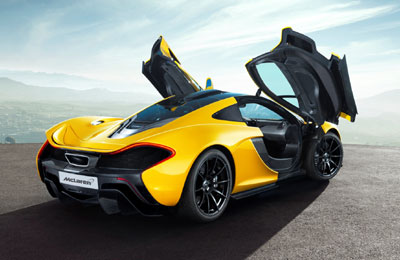
McLaren P1 production to start this year
Geneva, March 7, 2013
Production of the new McLaren P1 supercar will begin later this year at the new £40 million McLaren Production Centre (MPC) facility in Woking, Surrey, UK, it has been announced.
Production will be limited to 375 cars and will be carried out alongside the production lines of the 12C and 12C Spider.
The MPC is adjacent to the McLaren Technology Centre, where the car was conceived (and where McLaren’s Formula 1 team is based).
The astonishing new P1 debuted in production form at the Geneva Motor Show which opened today.
The P1 has a clear goal – to be the best driver’s car in the world on road and track. To achieve this objective, McLaren is using all of its 50 years of racing experience and success, especially in the fields of aerodynamics and lightweight carbon fibre technology, a statement said.
The result is a car that has an unprecedented amount of downforce for a road vehicle: similar levels to a GT3 racing car and yet with even greater ground effect. This downforce not only boosts cornering and braking performance. It also helps balance, stability and driveability at all speeds, it said.
‘McLaren introduced the carbon fibre chassis to the world of Formula 1 in 1981 with the MP4/1, and we had the first carbon-bodied road car,’ says McLaren Automotive executive chairman Ron Dennis. ‘We have always been at the cutting edge of vehicle aerodynamics, and all of this experience has gone into the new McLaren P1. Twenty years ago, with the McLaren F1, we raised the supercar performance bar. With the McLaren P1, we have redefined it once more.”
The best driver’s car in the world must also have exceptional straight-line performance and instant throttle response. To deliver this, the McLaren P1 uses an innovative IPAS petrol-electric powertrain comprising a substantially revised 3.8-litre twin-turbo V8 petrol engine, coupled to a single electric motor, collectively known as M838TQ. Combined power output is 916 PS (903 hp). As important as absolute power is the electric motor’s ability to provide instant torque, making the powertrain superbly responsive. It is also amazingly efficient. Carbon dioxide emissions are less than 200g/km, and it can cover more than 10 km in electric-only mode, it said.
Top speed is electronically limited to 350 km/h (217 mph), with the 0-100 km/h standing start acceleration taking less than three seconds .The McLaren P1 will power from rest to 200 km/h in less than seven seconds, and on to 300 km/h in less than 17 seconds – a full five seconds quicker than the McLaren F1.
‘We believe the McLaren P1 is the most exciting, capable, technologically advanced and most dynamically accomplished supercar ever made,’ said McLaren P1 programme director, Paul Mackenzie. ‘It may not be the fastest car in the world in absolute top speed, but that was never our goal. Rather, we believe it is the fastest ever production car on a racing circuit, a much more important technical statement, and far more relevant for on-road driving. It is a true test of a supercar’s all-round ability. Plus many owners will use the car on the circuit, at special track and test days.”
The technology developed for the McLaren P1 includes active aerodynamics and adjustable suspension – both now banned in Formula 1, due to being seen to give a performance advantage. Airflow is optimised around the body through the use of an active wing and underbody devices. The adjustable rear wing can extend from the bodywork by 120mm on road, up to 300mm on the race track, maximising the levels of downforce. The wing is directly inspired by Formula 1 design, with the intersection of the double element rear wing and design of the endplates being the same as that on the 2008 championship winning MP4-23.
In addition, the McLaren P1 also features adjustable ride height as part of the new hydro-pneumatic suspension. The revolutionary RaceActive Chassis Control (RCC) can lower the car by 50mm in Race mode, to produce ground effect aerodynamics. It also features adaptive spring rates, roll control, pitch control and damping, all providing a huge range of adjustment, making the McLaren P1 perfect for either road or track. In Race mode, the spring rates stiffen by 300 per cent, allowing the McLaren P1 to corner at more than 2g.
The revolutionary new carbon fibre MonoCage monocoque forms a complete structure incorporating the vehicle’s roof and its distinctive snorkel air intake - a styling feature inspired by the McLaren F1 road car.
The McLaren P1 name is also inspired by Formula 1. P1 refers to ‘first place’ or ‘position one’ – particularly fitting as McLaren has 182 Grand Prix victories and 155 pole positions to-date, in its 47-year Formula 1 history. There is also heritage in that name: the McLaren F1 was initially known internally within McLaren as Project 1, or P1, the statement said. – TradeArabia News Service







